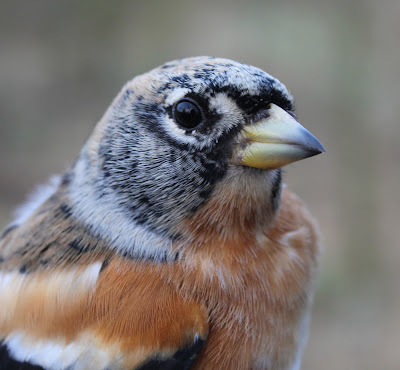Domestics kept the birding at bay this morning, so after a quick lunch it was time for a visit to Out Rawcliffe and a check on the finches.
I found the big flock first, 300+ mixed Chaffinch and Bramblings still feeding in roadside stubble where they have been most of the winter, flying back and forth to tall trees when they get disturbed. It was the farmer himself today, where after a run of dry days he had the tractor out pulling a plough back and forth over the very same field. As the finches flew to the tree tops it gave me chance to weigh up the ratio of over 250 Chaffinch and at least 15/20 Brambling.
Less than a mile away were my productive Brambling and Chaffinch feeders and the seed drop where I found at least 8 more Bramblings but only similar numbers of Chaffinch - there’s something about that seed mix which brings in the Bramblings. I promised myself another ringing session at the first opportunity, maybe tomorrow or Wednesday as both days should be dry without too much wind to blow the nets. Still 18+ Reed Bunting on site together with 25+ Goldfinch and single Linnet and Yellowhammer today. Captures of the target species just here from November 1st to date read as 66 Chaffinch, 37 Brambling, 36 Reed Bunting and 28 Goldfinch - fascinating days!
Brambling
Chaffinch
Many low-lying local farms appear to be still saturated from the deluges of last summer, the autumn and early winter, and a walk around the area still requires wellies in places; and there’s still snow on them thar hills.
Rawcliffe Moss
Over towards the still soggy fields of Pilling Moss I could see the Lapwing flock, more than 200 of them sometimes panicking into wayward flight with their antics lifting the Golden Plover and the Black-tailed Godwits too, 15 and 32 respectively today.
Woodpigeons numbers have been dropping of late, losing noughts rapidly with 300+ today. Fieldfare numbers down too with less than 20 in the tall trees with the aforementioned large Chaffinch flock.
Afternoon is not the best time for a Barn Owl, but I did find evidence of their comings and goings along a favourite fence route, a fairly fresh pellet.
Barn Owl pellet
Raptors on this grey day, 4 Buzzard, 2 Kestrel and 1 Sparrowhawk.
Kestrel
Try Another Bird Blog soon and see how the numbers add up after Tuesdays effort - I'm counting on it.
And this post is also linking to Stewart in Australia for World Bird Wednesday.














































.jpeg)









.jpg)












